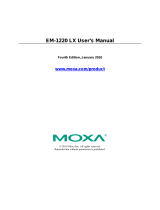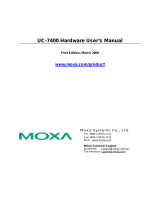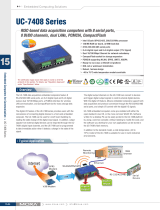
UC-7101 Hardware Introduction
Product Features
UC-7101 series computers have the following features:
• Moxa ART ARM9 32-bit 192 MHz processor
• 16 MB RAM (about 12 MB of user programmable space)
• 8 MB Flash ROM (about 4 MB of user programmable space)
• One 10/100 Mbps Ethernet port for network redundancy
• One software-selectable RS-232/422/485 port
• Variable 50 bps to 921.6 kbps baudrate
• SD socket for storage expansion
• Built-in RTC, buzzer, WDT (watch dog time)
• Built-in μClinux Kernel 2.6 platform
• -40 to 75°C wide temperature models available
• DIN rail or wall mountable
• Robust fanless design
Hardware Specifications
MOXA ART ARM9 32-bit RISC CPU, 192 MHz
(pre-installed): μClinux or Linux
16 MB
8 MB onboard
SD slot
Auto-sensing 10/100 Mbps (RJ45), 1 port
Magnetic Isolation Protection:
1.5 kV built-in
Standards: RS-232/422/485 software-selectable (DB9 male), 1 port
15 kV ESD for all signals
RS-232 (TxD, RxD, GND) 4-pin pin header output
Serial Communication Parameters
5, 6, 7, 8
1, 1.5, 2
None, Even, Odd, Space, Mark
RTS/CTS, XON/XOFF, ADDC® (automatic data direction control) for RS-485
50 bps to 921.6 kbps (supports non-standard baudrates; see user’s manual for details)
-232: TxD, RxD, DTR, DSR, RTS, CTS, DCD, GND
-422: TxD+, TxD-, RxD+, RxD-, GND
-485-4w: TxD+, TxD-, RxD+, RxD-, GND
-485-2w: Data+, Data-, GND
Ready
LED located on the RJ45 connector
10M/Link x 1, 100M/Link x 1
TxD x 1, RxD x 1





















